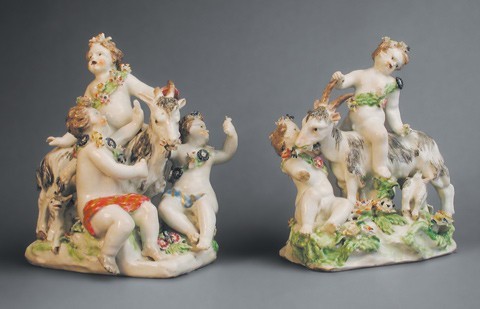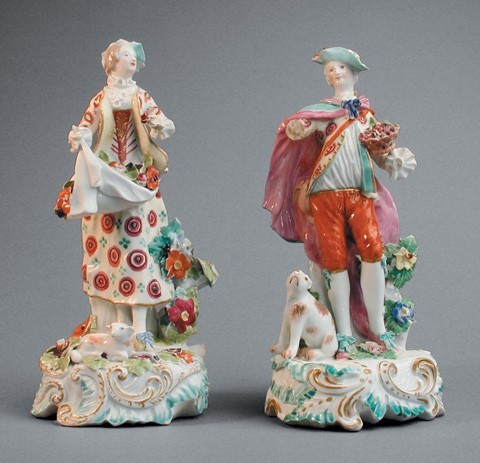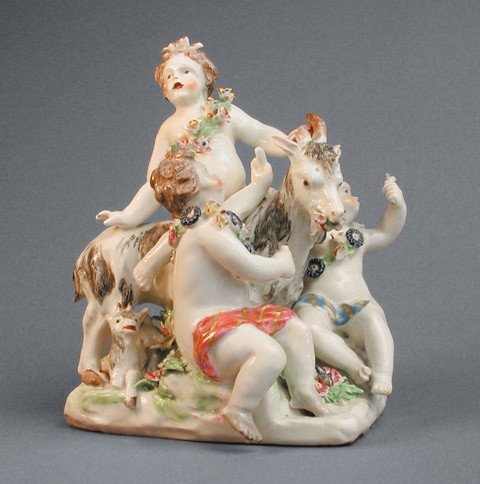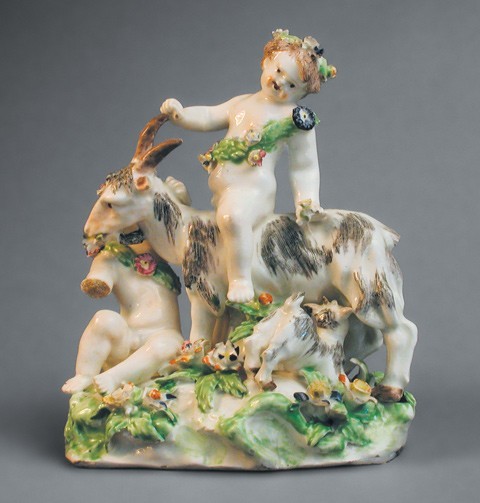
Pair of goats with putti, Bow Porcelain Factory, London, 1759–1769. Soft-paste porcelain. H. 7" and 6 1/2". (Courtesy, City of Bowie Museums; all photos, Richard Rohlfing.)

Pair of gardeners, Derby Porcelain Works, Derby, 1759–1769. Soft-paste porcelain. H. 9 1/2".

Figure of Mars, Derby Porcelain Works, Derby, 1759–1769. Soft-paste porcelain. H. 7".

Billy goat, Bow Porcelain Factory, London, 1759–1769. Soft-paste porcelain. H. 7".

Nanny goat with putti, Bow Porcelain Factory, London, 1759–1769. Soft-paste porcelain. H. 6 1/2".
Documentary evidence for the use of ceramic figures in eighteenth-century American households is extremely rare—much less the actual survival of such pieces. Recently, however, five English soft-paste porcelain figures dating from the 1760s have come to light that provide an important illustration of elite choices by early American consumers in acquiring and displaying decorative ceramics. The figures now belong to the City of Bowie Museum’s Belair Mansion, a 1745 plantation house first owned by a colonial governor of Maryland, Samuel Ogle (1690–1752), and then by his son, Benjamin Ogle (1749–1809), a state governor. The figures, which had remained in the possession of direct descendants of the Ogle governors, were rediscovered during the restoration and research for furnishing the house as a museum.
The five pieces consist of three groupings: two Bow goats with putti (fig. 1), a Derby gardener paired with his female counterpart (fig. 2), and a lone Derby figure of the Roman god Mars (fig. 3). The Bow figures date to circa 1760, and have pad bases with raised flowers and a square potting hole in the back. On one, three cherubim frolic on a billy goat (fig. 4). On the other, two cherubim sit on a nanny goat with her kid (fig. 5).[1]
The Derby gardener figures stand on rococo bases full of C-scrolls and floral motifs, and carry baskets of flowers and vegetables. Their dress is not that of working gardeners but rather the frivolous costuming associated with the rococo taste. With his contraposto pose, the Mars figure speaks less of war and more of classically inspired art.
The porcelain figures represent a type often used as mantle garniture in the eighteenth century. Importantly, family descendants can attribute their purchase to Governor Benjamin Ogle. The figures cumulatively can be traced to a narrow range of dates between 1759 and 1769. This coincides with the period in the mid-1760s when young Benjamin was studying at Eton in England, where he very possibly may have purchased them. An examination of contemporary merchant records for Annapolis, where the Ogles owned a townhouse from the 1740s to 1815, reveal that no examples of this type appeared on shop shelves in the capital city.[2]
Intriguingly, the probate inventory for Benjamin’s son, Benjamin Ogle II (1796–1844) who died at Belair, lists “5 china mantle ornaments . . . 25¢,” suggesting that the figures, eighty years after their original purchase, were not highly valued by the inventory taker.[3] This listing, however, combined with the fact that the donor is a direct descendant of Benjamin Ogle, provides invaluable evidence to support the family tradition that these pieces were at Belair in the 1760s.
Stephen E. Patrick
Director, City of Bowie Museums
<spatrick@cityofbowie.org>
Peter Bradshaw, 18th Century English Porcelain Figures (Woodbridge, Suffolk, Eng.: Antique Collectors’ Club, 1981), p. 105.
Stephen Patrick, “Class and Consumerism: Ceramic Purchases in the Colonial Chesapeake,” Ars Ceramica 10 (1993).
Benjamin Ogle II probate, Prince George’s County, Maryland, Administration 400, Docket 1810, April 30, 1844.
